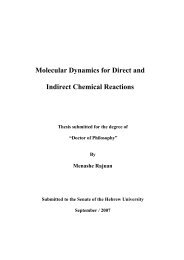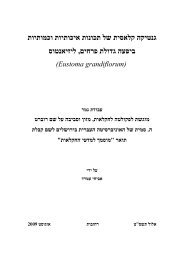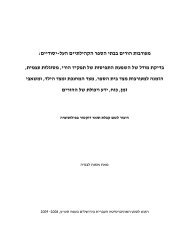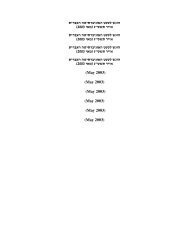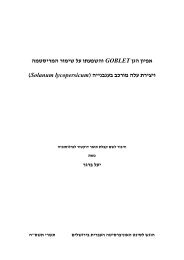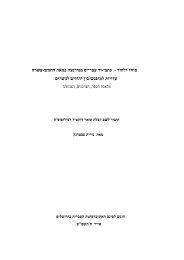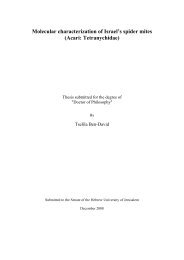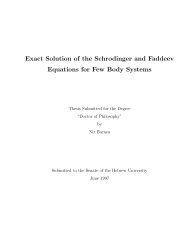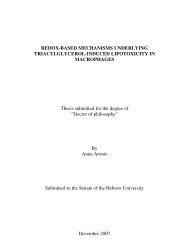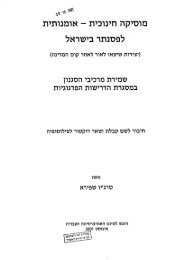Revealing the Mechanism of HSP104 Transcription Initiation in the ...
Revealing the Mechanism of HSP104 Transcription Initiation in the ...
Revealing the Mechanism of HSP104 Transcription Initiation in the ...
You also want an ePaper? Increase the reach of your titles
YUMPU automatically turns print PDFs into web optimized ePapers that Google loves.
<strong>Transcription</strong> under stress <strong>in</strong> S.cerevisiae<br />
Although several signal transduction pathways and some stress-<strong>in</strong>duced<br />
transcriptional activators have been identified (37, 38, 41, 87, 92, 96, 102, 133), we<br />
have only partial answers to some <strong>of</strong> <strong>the</strong> major questions raised above with respect to<br />
sens<strong>in</strong>g <strong>the</strong> stress and <strong>in</strong> turn activat<strong>in</strong>g transcription. This issue is never<strong>the</strong>less better<br />
understood <strong>in</strong> S.cerevisiae than <strong>in</strong> any o<strong>the</strong>r experimental system. A large number <strong>of</strong><br />
stress responsive systems have been discovered <strong>in</strong> this organism <strong>in</strong>clud<strong>in</strong>g several<br />
transcriptional activators whose activity is <strong>in</strong>duced by specific stresses (e.g. yAP1,<br />
Gcn4, Gln3) (41, 84, 88, 92). Ano<strong>the</strong>r activator, Hsf1, that is <strong>in</strong>duced ma<strong>in</strong>ly by<br />
elevated temperature, but also by o<strong>the</strong>r stresses [(52, 83, 90, 133) and see below] and<br />
yet two more activators, Msn2 and Msn4 that are activated <strong>in</strong> response to any stress<br />
[(17, 87, 110) and see below]. As promoters are usually complex, conta<strong>in</strong><strong>in</strong>g several<br />
enhancer elements, it is most probable that none <strong>of</strong> <strong>the</strong>se activators is act<strong>in</strong>g alone on<br />
target promoters, but cooperate with one <strong>of</strong> <strong>the</strong> o<strong>the</strong>r stress-<strong>in</strong>duced activators (4, 29,<br />
47), or with o<strong>the</strong>r activators, not necessarily <strong>in</strong>duced by stress (39, 53, 65, 72, 80, 93,<br />
123). It is still unclear how two or more activators co-act on <strong>the</strong> same promoter.<br />
Recent studies addressed <strong>the</strong> changes <strong>in</strong> <strong>the</strong> organization <strong>of</strong> chromat<strong>in</strong> that<br />
occur on stress responsive promoters upon activation (21, 36, 128, 135, 136). It was<br />
found that many promoters undergo extensive chromat<strong>in</strong> remodel<strong>in</strong>g (i.e.,<br />
nucleosomal disassembly follow<strong>in</strong>g histone acetylation) upon activation and that <strong>the</strong><br />
complexes responsible for this modification are <strong>in</strong> fact recruited by transcriptional<br />
activators (21, 36, 128, 135, 136). It should be noted that most studies address <strong>the</strong><br />
question at <strong>the</strong> whole genome level and <strong>the</strong>ir conclusions are <strong>the</strong>refore grossly<br />
general. The epistatic relationships between recruitment <strong>of</strong> transcriptional activators<br />
and changes <strong>in</strong> chromat<strong>in</strong> structure are not well established <strong>in</strong> many cases. Also, it is<br />
also not fully understood how RNA PolII and <strong>the</strong> factors <strong>of</strong> <strong>the</strong> basal transcription<br />
mach<strong>in</strong>ery function under stresses such as heat shock, when many prote<strong>in</strong>s are<br />
denatured. One <strong>of</strong> <strong>the</strong> RNA PolII subunits, Rpb4, is essential only under stress, and<br />
seems to be <strong>in</strong>volved <strong>in</strong> <strong>the</strong> <strong>in</strong>duction <strong>of</strong> some stress related genes (23, 89, 97, 98). It<br />
may also function as a stabilizer <strong>of</strong> RNA PolII under stress (23, 104). It is not clear<br />
whe<strong>the</strong>r o<strong>the</strong>r components <strong>of</strong> <strong>the</strong> PIC are specifically important for transcription<br />
under stress.<br />
In an attempt to understand <strong>the</strong>se aspects <strong>of</strong> <strong>the</strong> mechanisms <strong>of</strong> transcriptional<br />
activation under stress, we have been focus<strong>in</strong>g on <strong>the</strong> <strong>HSP104</strong> promoter. This<br />
6



